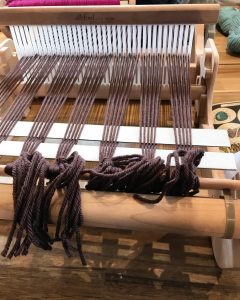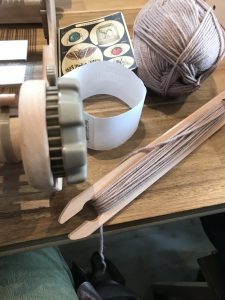During weeks 6 and 7, I was able to attend a two part weaving course at the Nifty Knitter in Issaquah. It was a very introductory level course, but I found the teaching style/community to be much less welcoming than what I had experienced at Arbutus.

I successfully wove my very first scarf and was super pleased with the outcome and the level of ease that is associated with simple weaving, however I was not thrilled with the approach that the teacher took in instruction us beginning weavers. For the past seven weeks, my work has led me to the conclusion that in fashion and textiles, visual perfection and symmetry will always be overrated. I believe its one of the main reasons we have so much waste with textiles being produced on an industrial scale, and also the reason that small craftspeople cannot compete with machine-rendered textiles. While I was at the weaving class, the teacher kept emphasizing perfection, symmetry, cleanness of lines, and other aspects that actually had nothing to do with the structural integrity of the garment and instead, in my opinion, wasted time and material. She kept stressing how difficult weaving is and how much work it takes you to be perfect, but the whole time I could not stop myself from being incredibly skeptical about her comments.

Overall, I felt like the craft world in this particular community was one reserved for rich old ladies who needed something to fill their time and pour their excessive disposable income into (I was the youngest in the room by 30 years), it was not meant to be a useful task. This is unfortunately what I think a lot of the craft world in the United States is saturated with. It is not made to be a practical, attainable skill – if it were, there would be no lucrative market for it at all.
Why do the lines need to be perfectly lined up? Why can’t there be little snags or fluffs here and there? Sure, a machine wouldn’t do it that way, but if a machine can do it better, why are we even doing it at all? I think the answer to that last question goes back to what I have been finding to be the most prominent theme in the conclusions I have been making: human interaction with fiber and fabric creates a narrative that industrialized machinery is sorely lacking.

Overall, it took me about 13 hours of weaving to finish my scarf. In order to make the minimal living wage from that amount of work (let’s say $11/hr), I would need to charge about $150 for it. To be honest, with the scarf that I made from the boring, textureless, perfect yarn that I was given alongside instructions to be as precise as possible, I would not in a million years pay $150 for that scarf. I do believe, however, that there is a way to create something that is totally unique and quite priceless when you allow your work to have personality in every step of its life cycle. From the methods employed to spin, weave, finish, dye – each and every stop allows for an opportunity to create something completely and entirely its own story.